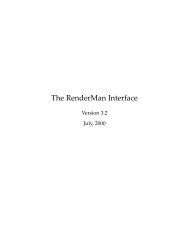Rag doll physics simulation - NCCA People A-Z
Rag doll physics simulation - NCCA People A-Z
Rag doll physics simulation - NCCA People A-Z
Create successful ePaper yourself
Turn your PDF publications into a flip-book with our unique Google optimized e-Paper software.
direction of contact to a certain magnitude in distance. For a better understanding of how thisis computed we will explain in more detail and go through the steps necessary to successfullyachieve an effective collision <strong>simulation</strong> between bodies.4.4.1. Closing and separating velocitiesAs defined by Ian Millington (2007), the total speed at which two objects move together isknown as closing velocity. This calculation uses a scalar value and direction without needing touse a vector representation. This is done by taking the sign of the scalar value to determine thedirection where the velocity will be applied. See Equation 13.⃗⃗⃗⃗⃗ ( ̂ ) ⃗⃗⃗⃗⃗ ( ⃗⃗⃗⃗⃗ ̂ ⃗⃗⃗⃗⃗ )EQUATION 13: CLOSING VELOCITY BETWEEN TWO BODIESWhere the closing velocity of the two bodies is , ⃗⃗⃗⃗⃗ is the position of body and ⃗⃗⃗⃗⃗ is theposition of body . The values ⃗⃗⃗⃗⃗ and ⃗⃗⃗⃗⃗ are the velocities for body and respectively.According to Equation 13, in order to obtain the closing velocity of both objects in scalar formwe take the velocity of body and apply a dot product (also known as scalar product of avector) of the vector of the velocity with the resulting vector of the difference in positionbetween body and body from body ’s point of view and then proceed to do the same forbody ’s point of view and add both values together to get the resulting velocity. A moresimplified representation would be the one shown in Equation 14 (Millington, 2007).( ⃗⃗⃗⃗⃗ ⃗⃗⃗⃗⃗) ( ⃗⃗⃗⃗⃗ ̂ ⃗⃗⃗⃗⃗ )EQUATION 14: SIMPLIFIED CALCULATION OF CLOSING VELOCITYAccording to Equation 14, when two bodies close on each other the resulting relative velocitywill be negative, and when they are separating away from each other it will be positive. So, bychanging the sign from Equation 14 we would get a separating velocity ( ) represented inEquation 15 (Millington, 2007).( ⃗⃗⃗⃗⃗ ⃗⃗⃗⃗⃗) ( ⃗⃗⃗⃗⃗ ̂ ⃗⃗⃗⃗⃗ )EQUATION 15: SEPARATING VELOCITY BETWEEN TWO BODIESFor a visual representation of both types of relative velocities between two bodies refer to Figure4 and Figure 5.⃗⃗⃗⃗⃗⃗⃗⃗⃗⃗FIGURE 4: CLOSING VELOCITY BETWEEN TWO BODIES18















